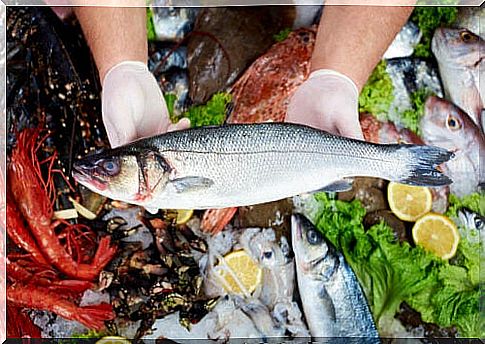Fish We Should Avoid

Fish in general are known to be an important source of essential nutrients. However, there are some species that can transmit heavy metals or foodborne diseases. Do you know which fish we should avoid?
The World Health Organization (WHO) points out that the main source of human exposure to toxic compounds is through the consumption of fish and shellfish. In particular, these substances affect health and, above all, pose a significant risk to pregnant and lactating women.
Why are there some fish we should avoid?
It has been known for years that a wide variety of marine species, especially those found in the lower levels of the food chain, can accumulate metals such as cadmium, lead and mercury from activities such as mining, livestock, agriculture, among others.
Concentrations become so high that they can be lethal. The massive poisoning that occurred in Minamata Bay, Japan, in the early 1950s, is the best known case of poisoning resulting from the consumption of fish with high mercury content.

Effects of Mercury on Human Health
According to a study published in the Chilean medical journal, mercury toxicity in fish is associated with the chemical form, type, exposure dose and age at which it occurs. When this metal is released into the environment, it undergoes a series of transformations and participates in cycles between the atmosphere, ocean and land.
The percentage that ends up in water, which is 5%, is elemental mercury and accumulates in sediment. This occurs in lakes, ponds and swamps as well as in estuaries and oceans. The bacteria that live there convert it to methylmercury, which is then extracted by worms, earthworms and other animals.
This is the organic substance that fish end up ingesting, and it is the one that manifests the greatest toxicity to living organisms, as it causes problems in the following structures:
- Nervous system.
- Immune system.
- Kidneys.
- Digestive system.
- Lungs.
- Skin.
- Eyes.
Fish We Should Avoid Regularly Consuming
As we mentioned earlier, there are species that can live for over 100 years. Therefore, the ingestion of these substances throughout life increases their potential for toxicity.
Likewise, larger fish consume higher amounts, as consumption is proportional to their size. Below, we tell you which fish we should avoid so as not to harm our health.
Mackerel ( Scomberomorus cavalla )
Mackerel is a marine fish with an elongated and fusiform body. Its muzzle is pointed and its mouth is wide. In addition, it has large eyes that are surrounded by a closed bony ring. The body is covered with small scales, with a bright blue-green back, light green flanks and a silver underside.
It is usually 65 centimeters long, but males can reach a length of up to 2 meters. This species lives in the Atlantic Ocean, from Canada and Massachusetts (United States) to São Paulo (Brazil).
Blue Marlin ( Makaira nigricans )
It is a species of Marlin that can exceed 4 meters in length, although it usually measures between 1.80 and 3 meters. It is also known by other names, such as “Atlantic blue marlin”, due to the color of the dorsal fin. However, it is white and silver in the belly area.
Its body is elongated and has two dorsal fins. In relation to the upper jaw, it is shaped like a sword. This fish generally lives in the subtropical and tropical waters of the Atlantic, including the coasts of the Canary Islands.
We can also find it in the Pacific and Indian oceans. Females weigh up to 450 kilos, while males do not exceed 160 kilos.
Hoplostethus atlanticus
This marine fish inhabits the east and northwest of the Atlantic ocean, the south of the Pacific ocean and the Indian ocean. Its body is oval and quite elongated. It has a big head, small eyes and tiny teeth. It has a dark orange coloration on the body and red on the head.
It inhabits depths from 180 to 1500 meters and its capture is incidental with trawl nets. This species is one of the oldest known to exist. It is estimated that it can live up to 180 years, therefore, it would be the oldest fish in nature.

Common cod ( Gadu morhua )
Common cod, also known as “ Atlantic cod ” or “ Norwegian cod ,” is one of 60 species of migratory fish. It inhabits the North East Atlantic Ocean, from the Barents Sea to the Bay of Biscay, including the waters of Iceland, Greenland and the Baltic Sea.
It is usually small in size, although some specimens reach 2 meters in length and weigh up to 100 kilograms. They feed on other fish, such as herring or sardines. It is 600 meters deep.
Bull’s Eye Tuna ( Thunnus obesus )
The bull’s eye tuna is one of the species that can contain a lot of mercury. However, the same is not true for tuna from the Mediterranean. This variety is also known as “albacore” or “pelagic fish”.
It lives in tropical and subtropical areas of the Atlantic, Indian and Pacific, but is absent in the Mediterranean Sea. It can measure 2.50 meters in length, but it usually reaches 1.80 meters with an age of approximately 15 years.
Conclusion on fish we should avoid
These are some species that can accumulate heavy metals in excess, especially methylmercury. However, there are other fish that contain this substance, but in amounts that are usually not significant.
The most vulnerable to these toxic substances are women of reproductive age, pregnant women, mothers who are breastfeeding and children under 2 years, given the negative effects that these compounds have on health. Of course, that doesn’t mean they don’t affect other population groups.
Remember that eating moderate portions of some of the fish described will not harm your health. So you can do this occasionally by avoiding overeating.









